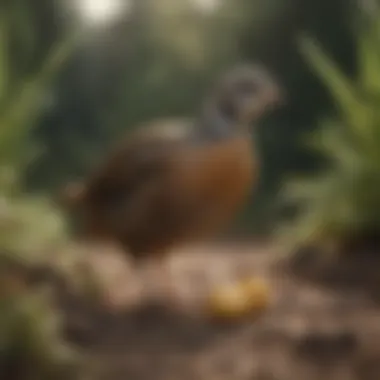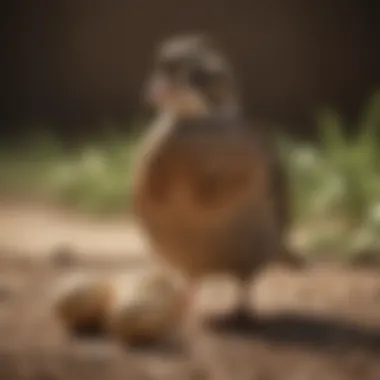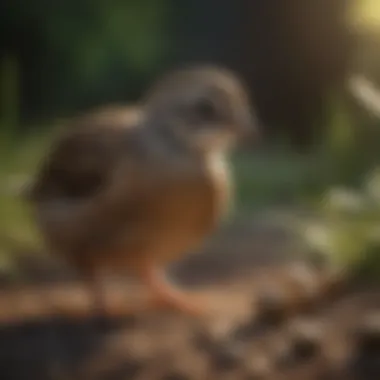The Ultimate Guide to Quail Chick Nutrition


Intro
Feeding quail chicks effectively is crucial for their growth and health. Understanding their dietary needs helps prevent problems that may arise from improper feeding. This guide aims to provide clear and actionable insights on what quail chicks require to thrive. From nutritional components to feeding schedules, every detail plays a role in their development.
Nutritional Needs of Quail Chicks
Quail chicks necessitate a diet rich in protein, vitamins, and minerals during their formative weeks. The initial feeding phase lasts approximately 0-6 weeks, where they require approximately 24-28% protein content in their feed. Key dietary components include:
- Starter Feed: A specially formulated feed containing high protein.
- Crushed Grains: Provide texture and additional nutrients.
- Greens: Small amounts of finely chopped leafy greens can enhance their diet.
Carefully measure these components to ensure balanced nutrition. The diet can shift as the birds mature, but early attention to their requirements lays a solid foundation for health.
Feeding Schedules
Establishing a consistent feeding schedule is vital for quail chicks. Instead of offering unlimited food, structured feeding can help regulate intake and monitor eating habits. A recommended schedule might include:
- Day 1-7: Feed 3-4 times daily.
- Week 2-3: Reduce to 2-3 times daily.
- Week 4-6: Adjust to 2 times daily.
It is essential to observe the chicks' behavior during meal times. If they seem lethargic or are not eating, consider reassessing the feed quality or consult a veterinarian.
Potential Challenges
Feeding quail chicks comes with its challenges. Some common issues include:
- Overeating: Can lead to health problems.
- Inadequate Nutrients: Poor feed quality affects growth.
- Contamination: Keeping feeders clean is vital to avoid disease.
Proactive measures can mitigate these problems. Regular checks on feed freshness and cleanliness are vital for ensuring healthy growth.
Best Practices for Optimal Health
To ensure optimal growth and health of quail chicks, consider following these best practices:
- Provide fresh water at all times. Hydration is key to their wellbeing.
- Monitor feed consumption to identify any health issues early.
- Gradually introduce new foods to avoid digestive upset.
Regular observation and care can make a significant difference in the health of quail chicks as they grow.
"A well-fed quail chick is the foundation for a healthy flock."
By adhering to these guidelines, both novice and experienced poultry enthusiasts can effectively nurture quail chicks from hatching to maturity. Understanding their diets is not just about maintenance, but about fostering their ultimate potential.
Understanding Quail Chicks' Nutritional Needs
Feeding quail chicks requires a careful understanding of their nutritional needs. This phase of their life is crucial for healthy growth and development. Insights into the dietary requirements help ensure that they receive the right combination of nutrients to thrive. The article will explore essential aspects of their diet, emphasizing the balance necessary to foster optimal health. Understanding these needs can prevent many common health issues and enhance the overall well-being of quail chicks.
Basic Dietary Requirements
Quail chicks have specific dietary needs that change as they grow. For the first few weeks, their diet must be high in protein and balanced in other nutrients. Typically, the diet should consist of at least 24% protein. This is critical for their rapid growth during this period.
- Protein sources may include:
- Chick starter feed commonly designed for game birds.
- Crushed insects or mealworms, providing natural nutrition.
Besides protein, providing adequate carbohydrates and fats is also important. Carbohydrates can come from grains like corn or oats, while fats can be included through seeds or oils.
Water is also vital. Fresh and clean water should always be accessible. Dehydration can lead to serious problems, even in healthy chicks.
Importance of Protein
Protein is a cornerstone of the quail chicks' diet. Young birds depend on protein to support tissue growth and overall development. Insufficient protein intake can result in stunted growth and a weakened immune system. Therefore, it is essential to choose the right feed.


The best protein sources are those that provide essential amino acids. These are components that quail cannot synthesize on their own. Key amino acids include lysine and methionine. For the best results, select feeds that specify a complete amino acid profile.
Role of Vitamins and Minerals
In addition to proteins, vitamins and minerals play a critical role in the health of quail chicks. Vitamins such as A, D, and E are crucial for growth, vision, and immune function. A deficiency in these vitamins can cause a range of health issues.
Minerals such as calcium and phosphorus are equally important. These minerals contribute to bone development and strength. A notable imbalance can result in deformities and growth problems.
To ensure that quail chicks receive adequate vitamins and minerals, choose a formulated feed that includes them, or consider a supplement designed for game birds. Regular monitoring is also important to identify any potential deficiencies early.
"Correct nutrition is foundational for the successful raising of quail chicks."
In summary, understanding the nutritional needs of quail chicks is essential for any breeder. Providing the right balance of proteins, vitamins, and minerals ensures healthy growth that sets the foundation for their maturity.
Feeding Strategies for Quail Chicks
Feeding strategies for quail chicks are essential to their development. Proper nutrition is vital in the early stages of life. Quail chicks require specific diets for growth, health, and optimal performance. Strategies help ensure consistent intake of nutrients. They also reduce the risks of deficiency and related health problems. This section will discuss starter feed options, how to create homemade feeds, and address watering needs and procedures.
Starter Feed Options
Quail chicks benefit from high-quality starter feeds. These feeds are formulated specifically for their nutritional needs. It is usually higher in protein compared to regular poultry feed. A protein content of 24% to 28% is ideal for them. You can find starter feeds in many agricultural stores or online. Look for brands such as Purina or Kalmbach, as they offer specialized quail chick feeds.
Additionally, pay attention to the formulation. A complete feed includes essential amino acids, vitamins, and minerals. These elements play a crucial role in overall health. It is wise to start feeding chicks from day one. Consistency is key, as it encourages proper growth and digestive health.
Homemade Feed Recipes
Making homemade feed can be rewarding. It allows you to control the ingredients. This can ensure quality and nutrition levels. A balanced homemade feed can include:
- Crush grains like corn and wheat
- Protein sources such as soybean meal or fish meal
- Supplements like calcium, vitamins, and minerals
A basic recipe might include:
- 40% corn
- 30% soybean meal
- 15% wheat
- 15% minerals and vitamins
Mix these ingredients well. Ensure the final product is finely ground to prevent choking. It is essential to monitor the chicks' growth while using homemade feed. Adjust the recipe if needed to fit their developmental stage.
Watering Needs and Procedures
Water is crucial for quail chicks. Maintaining proper hydration affects their metabolism and growth. Always provide clean, fresh water. Use shallow dishes to prevent drowning. It is advisable to refill these dishes frequently. Check for cleanliness as well.
During the first week, quail chicks may not drink enough water. So, you can use water with a bit of sugar to encourage drinking. Replace this mix with regular water after a few days.
Feeding Timelines for Quail Chicks
Feeding timelines play a crucial role in the overall health and growth of quail chicks. By adhering to specific schedules, caregivers can ensure that each chick receives the proper nutrients at the right stages of development. An understanding of these timelines helps to avoid potential health issues and promotes a robust growth trajectory.
Immediate Post-Hatching Care
The period right after hatching is critical for quail chicks. During this stage, they are adjusting to their environment and require close monitoring. It is essential to provide access to starter feed within 24 hours after hatching. Starter feed should contain about 24% protein, which is vital for their early growth. This protein-rich diet supports muscle development and overall vitality.
In addition to feed, fresh water must be available at all times. Quail chicks can quickly become dehydrated. Place shallow water containers to allow easy access. Ensure that water is clean to avoid contamination, which can lead to health problems.
Growth Phases and Dietary Adjustments
As quail chicks grow, their dietary needs evolve. Different growth phases require adjustments in feeding strategies to support their rapid development.
- Weeks 1-3: During the first three weeks, maintain a high protein diet. The chicks should continue on starter feed until they reach about three weeks of age. At this point, consider introducing additional items such as finely chopped greens or grains to diversify their diet.
- Weeks 4-6: Once the quail chicks are four weeks old, start to transition them to grower feed, which typically contains around 20% protein. This slower protein decline helps accommodate their changing growth patterns as they become more active.
- Weeks 7-8: By week seven, their diet can further shift towards a formulation meant for adult quails, which generally contains around 16% protein. Notably, gradual changes in diet are important as sudden shifts can lead to digestive issues.
These adjustments not only enhance growth but also help maintain the chicks' overall health and well-being as they move closer to reaching adulthood.
Common Feeding Challenges


Feeding quail chicks comes with various challenges, and understanding these challenges is crucial for their growth and survival. Recognizing potential issues early enables quail caregivers to take appropriate actions, ensuring that chicks receive the necessary nutrition. Addressing common feeding challenges reduces the risk of health complications and enhances the overall wellbeing of the birds. Here are some significant challenges in feeding quail chicks:
Dehydration Risks
Dehydration poses a serious threat to quail chicks, particularly in their early stages of life. Young birds depend heavily on a consistent supply of water. Lack of adequate hydration can lead to numerous health issues, including reduced growth rates and a weakened immune system.
Signs of dehydration in quail chicks include lethargy, fluffed feathers, and a reduced appetite. To mitigate this risk, caregivers should ensure that clean, fresh water is always available. Using shallow, easy-to-access containers can help prevent drowning incidents.
It's essential to monitor water intake daily. If chicks seem less active or show signs of distress, providing electrolytes may also be beneficial. These special solutions can help restore hydration levels and support healthy development.
Feed Contamination Concerns
Contaminated feed is another critical issue that can severely impact the health of quail chicks. Feed contamination can occur due to improper storage, pests, or subpar quality of ingredients. Spoiled feed can harbor mold or bacteria, leading to serious illnesses.
To avoid contamination, store feed in a cool, dry place, preferably in airtight containers. Regularly inspect the feed for any signs of spoilage or pests. Using high-quality commercial feeds or prepared homemade diets can considerably lessen this risk.
In addition, always wash feeding utensils and containers regularly. Sanitization helps prevent the buildup of harmful microorganisms that can affect chick health.
Recognizing Nutritional Deficiencies
Nutritional deficiencies can quickly become problematic if not addressed timely. Quail chicks require a balanced diet that meets their metabolic needs for growth and development. Insufficient intake of essential vitamins and minerals can lead to poor feathering, stunted growth, and increased susceptibility to diseases.
Common signs include lethargy, abnormal feather development, and poor growth rates. Caregivers need to be observant. A well-rounded diet should include a mix of proteins, vitamins, and minerals. Options like commercially available starter feeds are designed to meet these needs, but it is also possible to create homemade mixtures.
Regularly assessing the chicks' growth and health will aid in recognizing any deficiencies early. If issues are noted, consult a veterinarian or an avian nutritionist for additional guidance on improving the dietary plan.
Important: Early intervention is key when dealing with any feeding challenge. Assessing and adapting feeding strategies is vital for ensuring quail chicks achieve their growth potential.
Best Practices in Feeding Quail Chicks
Feeding quail chicks properly is crucial for their health and growth. Following best practices assures that they receive the nutrients they need in the right way. Attention to detail in feeding habits results in healthier and more resilient birds.
Feeding Utensils and Their Importance
The choice of feeding utensils can greatly impact how quail chicks access food. The right tools reduce waste and ensure consistent food supply. Using shallow feeders is often recommended. They allow easier access for baby chicks, reducing the chance of drowning in deeper containers.
Additionally, ensuring that feeders are placed at a comfortable height is vital. This allows chicks to eat without strain. Some effective feeders include:
- Trays: Help in observing consumption and preventing overcrowding.
- Tube Feeders: Minimize spoilage and maintain grain quality longer.
- Ground Feeders: Suitable for natural foraging, promoting healthy behavior.
Cleanliness is as important as the feeders themselves. Regularly washing them prevents mold and reduces risks of disease. This attention to detail nurtures overall health.
Maintaining Hygiene in Feeding Areas
Hygiene in feeding areas significantly affects the health of quail chicks. A clean feeding environment minimizes the risk of bacterial contamination and illness. Dirty feeding containers can harbor pathogens that lead to various diseases.
Regular cleaning should be a priority. After every feeding session, leftover feed must be removed. Spilled grain can attract pests and create unsanitary conditions. Daily sanitation routines may include:
- Washing Feeders and Waterers: Use safe cleaning agents and ensure thorough rinsing.
- Disinfecting Areas: Regularly clean the ground and surrounding areas.
- Monitoring for Signs of Pests: Ensure that the feed area is free from rodents or insects.
By establishing and maintaining hygiene practices, you protect the chicks' health, ensuring they grow into strong adults. This will result in better quality birds and a more rewarding raising experience for the owner.
"A clean feeding environment not only protects your birds but also simplifies management for the owner."
In summary, implementing diligent feeding practices and maintaining a clean environment is paramount. Together, these strategies ensure that quail chicks develop properly and thrive.
Transitioning to Adult Diet
Transitioning from a diet tailored for quail chicks to one suited for adult quail is a crucial phase in their development. This transition should be approached with careful consideration. Adult quails have different nutritional requirements compared to their younger counterpart. Understanding these distinctions ensures the health and productivity of adult quail.
In this section, we will explore the signs that indicate it is time to move quail chicks to an adult diet, along with the necessary gradual changes needed to make this transition smooth and effective.


Signs to Indicate Readiness
Noticing the correct signs of readiness can help guide the timing of the dietary change. Some key indicators include:
- Age: Generally, quail chicks are ready to switch to an adult diet around 6 to 8 weeks of age. This is when they have developed enough to handle tougher food textures.
- Feather Development: A visible change in feathering suggests that the chicks are maturing. Well-developed feathers are a sign of readiness for adult nutrition.
- Increased Activity: As quails grow, they become more active. Their growing energy levels require a richer diet that adult feeds provide.
- Curiosity towards Adult Feed: If chicks start pecking at adult feed sources or mimic the feeding behaviors of adult quails, it is a clear signal of readiness.
The successful transition period also depends on the individual growth rates of the chicks, so keep a close watch on them.
Gradual Diet Changes
Making abrupt changes to a quail's diet can lead to digestive issues and stress. Hence, a gradual transition is essential. Here’s how to approach it:
- Start Mixing Feeds: Begin by mixing the current chick starter feed with adult feed. A good starting mix could be 75% starter to 25% adult feed. This ensures that chicks still have access to familiar nutrients while introducing new components gradually.
- Increase Adult Feed Proportion: After a week or two, slowly increase the proportion of adult feed to 50%, and eventually to 100%. Each phase should last a few days, allowing the quails to adjust.
- Monitor Responses: During this period, pay attention to how quail chicks respond to the change in diet. Look for any signs of discomfort or changes in behavior.
- Hydration Consideration: Ensure the quails have constant access to fresh water. Changes in diet may increase thirst as they adjust to new food textures.
Through careful observation and systematic adjustment, the transition from chick to adult diet can be a smooth process, promoting the overall health and vitality of the quail.
The Role of Environmental Factors in Feeding
Environmental factors heavily influence the feeding habits and overall health of quail chicks. These factors include temperature and space availability, which are crucial in promoting a healthy growth environment. Understanding how these elements come into play helps poultry owners create a supportive atmosphere that fosters optimal nutrition and development.
Temperature and Its Effects
Temperature plays a significant role in the health of quail chicks. Newly hatched chicks are particularly vulnerable to temperature fluctuations. They are unable to regulate their body temperature effectively during the initial weeks of life. This can lead to heat stress or, conversely, chilling if they become too cold.
Optimal brooding temperatures are typically around 95°F (35°C) for the first week. Gradually, this temperature can be lowered by 5°F (approximately 3°C) each week until it reaches about 70°F (21°C). This gradual decrease helps the chicks adjust to a more stable environment as they grow.
When temperatures are too high, chicks tend to become lethargic, which reduces their feed intake. This can result in inadequate growth rates and overall weak health. Alternatively, too low a temperature can lead to increased feed consumption without proper weight gain, as the chicks expend energy trying to generate heat. Maintaining a stable temperature in the brooder can promote better feed conversion rates and healthier chicks.
Space and Mobility Considerations
Space is another critical environmental factor affecting feeder access and movement for quail chicks. Adequate space allows chicks to move freely, which is essential for their health and development. Overcrowding can lead to stress, aggression, and reduced feed consumption among the flock.
When designing a brooding area, it is important to ensure that each chick has enough space. A general guideline recommends about one square foot per chick during the early stages. This facilitates easier access to food and water while preventing the stress associated with overcrowding. Additionally, providing varied environments within the space can stimulate natural behaviors such as foraging, which can influence feeding habits positively.
A well-structured environment considering temperature and space leads to better feeding practices. Healthy quail chicks are more likely to thrive and reach their growth potential when these environmental factors are met adequately.
Monitoring Growth and Health Indicators
Monitoring growth and health indicators in quail chicks is essential for their development and overall well-being. As a pet owner or poultry enthusiast, observing these indicators can ensure that you are providing the best care possible. By monitoring growth patterns and health signs, one can identify potential issues early and make necessary adjustments to their care routine. This section provides important insights into how to assess weight gain and behavioral patterns to evaluate the health of quail chicks effectively.
Weight Gain Assessment
Regularly assessing the weight of your quail chicks is crucial. Weight gain serves as a primary indicator of their health and nutritional status. Healthy quail chicks typically gain weight steadily during their early weeks of life. A consistent weight increase reflects a proper diet and effective feeding practices.
- Establish a Baseline: When the quail chicks hatch, weigh them to establish a starting point. This recording will help you measure growth accurately.
- Monitor Regularly: Weigh the chicks at least once a week. Keep a growth chart to track their weight over time.
- Identify Growth Patterns: Look for consistent weight gain. A decrease or stagnant weight gain may suggest nutritional deficiency or health issues.
- Consider Growth Rates: Generally, quail chicks should gain around 10-20 grams per week. If they fall below this range, consult a veterinarian.
Weight gain should be paired with consideration for age and breed. For instance, different breeds of quail may have varying growth rates. Understanding these factors enhances the accuracy of your assessment.
Behavioral Observations
Behavioral observation complements weight assessment in monitoring the health of quail chicks. A chick's behavior is often an indicator of its overall well-being and can reveal potential problems that weight alone may not reflect.
- Active Behavior: Healthy quail chicks are typically curious and active. They explore their environment and interact with their peers. Limited activity could be a cause for concern.
- Vocalizations: Healthy chicks often communicate through chirping and peeping. Any significant change in vocalization can signal distress or illness.
- Feeding Habits: Observe how the chicks approach food. A decline in appetite may indicate health issues. Ensure they eat and drink regularly.
- Social Interactions: Monitor how quail chicks interact. They should engage in normal social behaviors such as pecking, grooming, and establishing a pecking order. Aggressive or overly passive behavior may hint at stress within the group.
"Successful monitoring combines both weight and behavior assessments. Recognizing subtle changes in either can lead to early detection of issues."
By maintaining a careful watch over both weight and behaviors, you can create an environment that supports the health and growth of your quail chicks. Taking these observations into account helps improve their quality of life and enhances your success as a poultry owner.
Finale
In this article, we discussed the essential components of feeding quail chicks, emphasizing key aspects such as nutritional needs, the significance of various feeding strategies, and the importance of monitoring growth. Understanding these elements is crucial for anyone involved in quail care. This guide not only serves as a foundation for novice poultry enthusiasts but also provides depth for those more experienced in the field.
The summarization of key takeaways is vital. It provides distilled information, allowing for quick reference and reinforcing the most important concepts. With clear insights on diet requirements, common challenges, and best practices, readers can enhance their knowledge on raising healthy quail chicks. Here are some points to consider:
- Nutritional Needs: Quail chicks require specific nutrients for optimal growth, including proteins, vitamins, and minerals.
- Feeding Strategies: From selecting starter feeds to making homemade options, various approaches can be tailored to individual scenarios.
- Monitoring Health: Keeping track of weight and behavior gives insights into the overall health of the chicks.
"Proper diet and care lead to healthy quail chicks, which in turn ensures a productive cycle for egg-laying or meat production."







